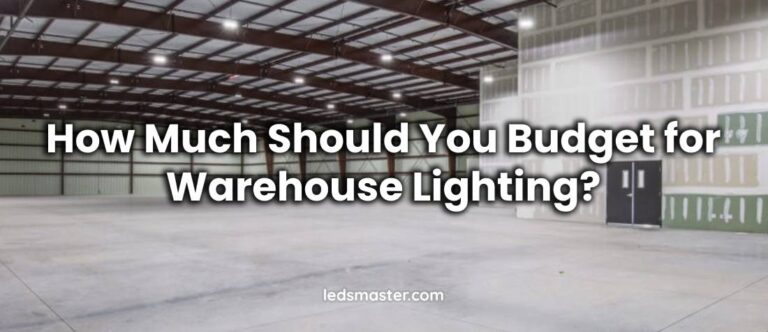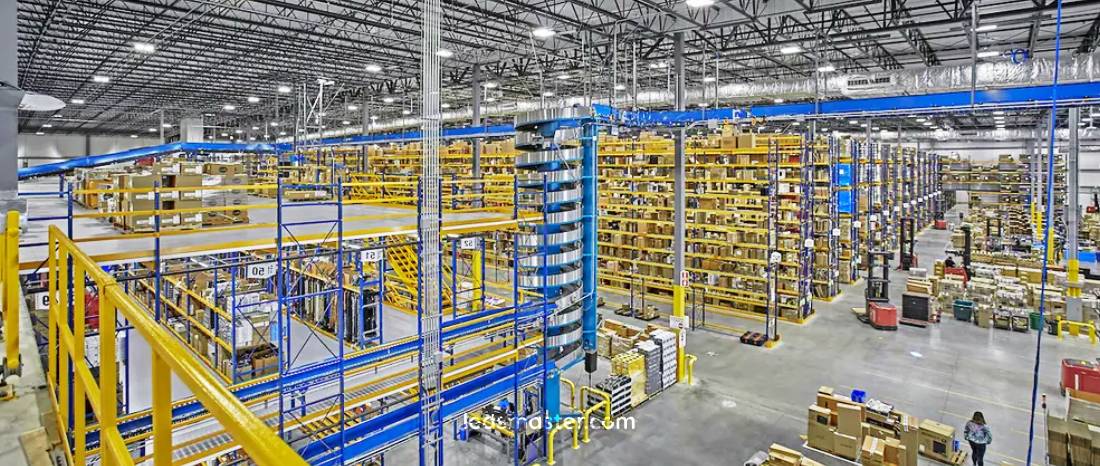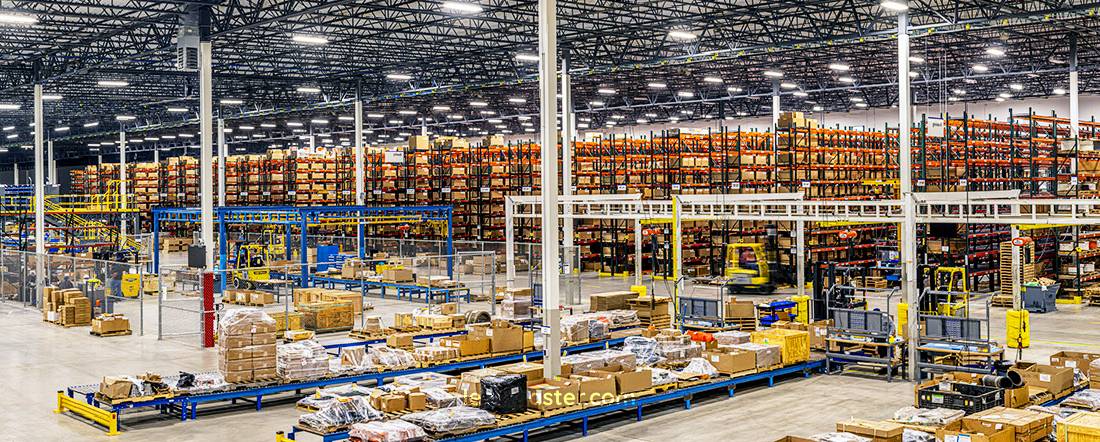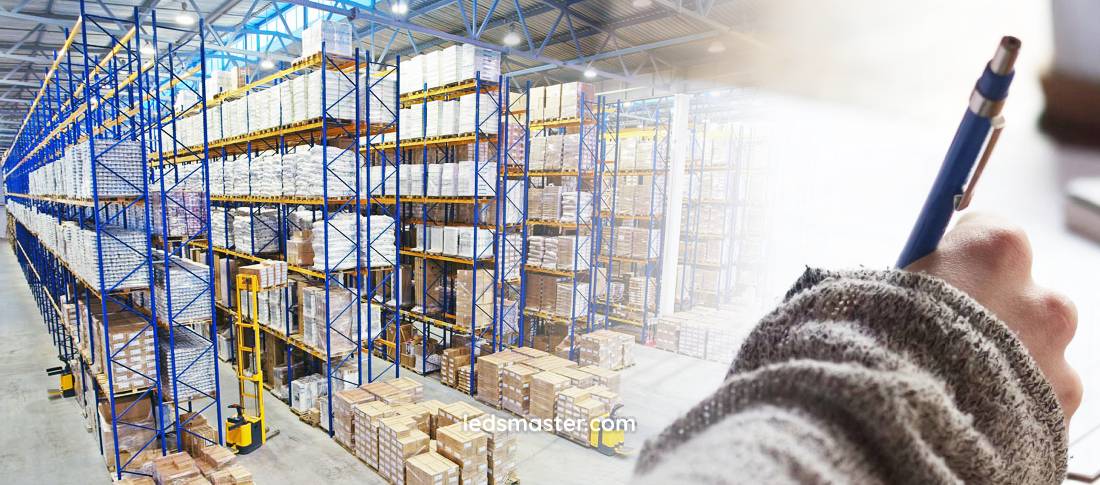
Whether you’re overseeing a large distribution center or a smaller storage facility, understanding the full scope of warehouse lighting expenses is essential for making informed decisions. From the initial investment in light fixtures to ongoing energy costs and maintenance, every aspect of warehouse lighting plays a role in your bottom line.
Get your complimentary lighting design today
When it comes to designing and outfitting a warehouse, lighting plays a major role in both operational efficiency and cost management. The expenses associated with warehouse lighting span multiple stages, from initial installation to long-term maintenance. It’s important for warehouse managers and business owners to have a clear understanding of the various cost factors involved, especially when making decisions about energy consumption, equipment selection, and the overall budget.
Warehouse lighting can be broadly divided into several categories: the cost of the lights themselves, the cost of installation, the ongoing running costs, and the costs related to maintenance. Additionally, the availability of funding and potential incentives for energy-efficient upgrades can influence the overall financial impact.
Table of Contents
ToggleThe cost of lighting is the first component to consider when planning for warehouse lighting. This includes both the purchase price of the light fixtures and the choice of technology that best suits the warehouse’s needs. Different types of lights come with varying price tags depending on factors such as energy efficiency, brightness, and longevity.

The most commonly used lighting options in warehouses are fluorescent, LED, and high-intensity discharge (HID) lamps. Each of these types has its own pricing structure.
Traditional fluorescent lights are less expensive upfront compared to LEDs but are becoming less popular due to their lower energy efficiency and shorter lifespan. A standard 4-foot T8 fluorescent tube can cost anywhere from $5 to $15 per unit, depending on brand and quality.
LED technology has surged in popularity in recent years, and although the initial cost is higher than fluorescent lighting, the energy savings over time often make it a better investment. An LED light fixture designed for warehouse use may range from $50 to $150 per unit, depending on the size and specification. LEDs are known for their energy efficiency and longer lifespan, typically lasting between 30,000 and 50,000 hours.
High-intensity discharge lamps are another option, often used for their bright, powerful light output. While they are common in large, open warehouse spaces, they are less energy-efficient than LEDs. HID lamps may cost anywhere from $30 to $120 per unit, and they typically last around 24,000 hours.
| Type of Light | Cost per Unit | Lifespan | Energy Efficiency | Other Notes |
|---|---|---|---|---|
| Fluorescent Lights | $5 to $15 per 4-foot T8 tube | 12,000 to 24,000 hours | Moderate | Lower energy efficiency, becoming less popular |
| LED Lights | $50 to $150 per fixture | 30,000 to 50,000 hours | High | More energy-efficient, longer lifespan |
| HID Lights | $30 to $120 per lamp | 24,000 hours | Low to moderate | Bright output, commonly used in large warehouses |

The decision on which type of light to install will depend on a variety of factors, such as the size of the warehouse, the layout, and the lighting requirements for specific tasks. For example, a warehouse that stores sensitive items might require brighter lighting, while a space that only needs basic illumination could make do with less intense fixtures. Additionally, energy efficiency is a major consideration, especially with the rising cost of electricity.
In recent years, the cost of LED lighting has dropped significantly, making it an attractive option for warehouses looking to reduce their energy consumption. Many warehouses find that while the initial expense is higher, the long-term savings on electricity bills and reduced maintenance costs make LEDs a more cost-effective option in the long run.
After choosing the right lighting system, the next major expense is the installation cost. This includes not only the price of labor to install the lighting fixtures but also any electrical work that may be required. Factors influencing installation costs include the complexity of the setup, the size of the warehouse, and whether the existing infrastructure needs upgrades.
Installation costs for warehouse lighting can vary depending on the size of the space and the complexity of the job. For a typical installation in a medium-sized warehouse, labor costs can range from $50 to $100 per hour. The number of labor hours required will depend on factors such as the height of the ceiling and the number of fixtures to be installed.
In some cases, the electrical system may need to be upgraded to handle the new lighting, especially if the existing system is outdated or incapable of supporting energy-efficient lighting. Upgrading electrical panels or running new wiring can add to the installation cost, potentially increasing the total expenditure by $1,000 to $3,000 or more, depending on the size and condition of the warehouse’s electrical system.
The complexity of the installation also influences the total cost. Installing lighting in a high-ceiling warehouse, for example, may require specialized equipment like lifts or scaffolding, which can increase both labor and rental costs. Additionally, if there are complex zoning requirements or specialized lighting needs, such as motion sensors or dimming features, these factors will also add to the total expense.
Overall, warehouse lighting installation costs can range anywhere from a few thousand dollars for a small facility to $10,000 or more for larger or more complicated setups.
Once the lighting system is installed, the ongoing running costs are an important aspect of the financial picture. These costs primarily involve electricity consumption, but they can also include additional charges for any automation systems, such as motion sensors or timers, that control the lighting.
The running cost of warehouse lighting depends heavily on the type of lights used, the number of hours the lights are on, and the efficiency of the system. LED lights, for example, consume far less energy than traditional fluorescent or HID lamps.
To calculate running costs, one must consider the wattage of the light fixtures. A typical LED light in a warehouse might use around 100 watts per fixture, while fluorescent lights could use up to 200 watts. Given that a warehouse may have dozens or even hundreds of lights running for several hours each day, this can add up quickly.
For example, if a warehouse has 100 LED lights running for 12 hours a day, the daily energy consumption would be calculated as follows:
100 lights × 100 watts = 10,000 watts (10 kW)
10 kW × 12 hours = 120 kWh per day
At an average electricity rate of $0.12 per kWh, the daily running cost would be $14.40. Over a month (30 days), the total running cost would be approximately $432.
Comparing this to fluorescent lights, which might consume double the wattage, the running costs would be significantly higher.
To further reduce running costs, many warehouses invest in lighting controls such as motion sensors, timers, or daylight harvesting systems that adjust lighting based on occupancy or natural light levels. These systems can help minimize unnecessary energy usage and, over time, lower electricity bills. The initial investment in these systems may be high, but the savings in running costs often provide a quick return on investment.
In addition to the cost of installation and running expenses, maintenance is another important factor to consider. Regular maintenance is necessary to ensure that the lighting system operates efficiently and lasts for its expected lifespan. The costs associated with maintenance include the replacement of faulty fixtures, routine inspections, and cleaning.
Most lighting systems require periodic replacement of lamps or bulbs. The frequency of these replacements depends on the type of lights installed and their expected lifespan. For example, LED lights generally require fewer replacements due to their longer lifespan, typically lasting between 30,000 and 50,000 hours. In contrast, fluorescent and HID lamps may need to be replaced every 12,000 to 24,000 hours of use.
When a lamp does need to be replaced, there are both material and labor costs. Replacing an LED light bulb can cost between $10 and $20 per unit, while fluorescent bulbs typically cost around $5 to $10. Labor costs for replacing bulbs can range from $50 to $100 per hour, depending on the difficulty of accessing the fixtures.
In addition to bulb replacement, warehouse lighting systems require periodic cleaning and inspection to ensure optimal performance. Dust and dirt can accumulate on fixtures, which can reduce the amount of light output and increase energy consumption. Regular cleaning of fixtures and lenses may cost anywhere from $500 to $2,000 per year, depending on the size of the warehouse and how frequently cleaning is required.
Over time, the lighting system may require repairs or upgrades. For example, ballasts in older fluorescent fixtures may need to be replaced, or control systems may require recalibration. These repairs can add to the maintenance cost, though they are typically less frequent than bulb replacements.

Upgrading a warehouse lighting system can be a significant financial commitment, but fortunately, several funding options and incentives are available to help offset the initial costs. For businesses looking to reduce their upfront investment, particularly those making the shift to energy-efficient lighting systems, there are various financial incentives provided by governments, utility companies, and even private lenders. These programs are designed to promote the adoption of more sustainable and energy-efficient technologies while easing the financial burden of the upgrade.
Energy-efficient lighting systems, such as LEDs, offer a range of benefits to warehouses, including lower energy consumption, reduced maintenance costs, and longer lifespan. However, the initial costs associated with installing these systems can be a barrier for many businesses. To encourage more companies to make the switch, various funding programs and financial incentives have been introduced to make these upgrades more affordable.
In many regions, local governments and utility companies offer rebate programs that can significantly reduce the cost of installing energy-efficient lighting. These rebate programs are often designed to incentivize businesses to transition to greener technologies, such as LED lighting, which can reduce energy consumption and lower overall carbon emissions. Depending on the region and the specific type of lighting system being installed, rebates can cover anywhere from 30% to 50% of the total cost of purchasing and installing new lighting. This financial assistance can be a huge advantage for warehouses looking to upgrade their lighting systems without incurring a large out-of-pocket expense.
Utility companies often have specific programs that encourage businesses to reduce their energy usage. These programs can include rebates, discounts on installation costs, or even direct incentives for adopting energy-efficient lighting systems. Many utilities provide these incentives as part of their efforts to meet energy conservation goals or reduce peak electricity demand. By working with a utility company, businesses can not only reduce their lighting costs but also contribute to a broader effort to reduce environmental impact.
In addition to rebates, certain tax credits and deductions are available for businesses investing in energy-saving technologies. For example, in the United States, businesses that upgrade to energy-efficient systems can benefit from programs like the Energy Efficient Commercial Buildings Deduction, which allows businesses to deduct a portion of the cost of upgrading their lighting systems from their taxable income. These tax incentives provide businesses with further opportunities to reduce the overall cost of their lighting upgrades.
While incentives can help cover a significant portion of the initial costs, some warehouses may still face challenges with the upfront expense of a lighting upgrade. For businesses that don’t have the capital to invest in a lighting system immediately, financing options can make the transition more manageable. Various financial institutions, such as banks or specialized lenders, offer loans designed specifically for energy-efficient upgrades. These loans often come with favorable terms, such as lower interest rates or longer repayment periods, to make the financial burden easier to handle.
Another option is to explore financing plans directly offered by lighting companies or energy service providers. Many lighting manufacturers and suppliers offer flexible payment plans that allow businesses to spread the cost of the upgrade over time. These financing options can help businesses manage their cash flow while still making the switch to energy-efficient lighting systems.
For warehouses that may have limited access to traditional financing, leasing options could also be available. With leasing, businesses can essentially rent the lighting equipment over a set period, which can lower the initial upfront cost. At the end of the lease, businesses can choose to purchase the equipment, renew the lease, or upgrade to a new system. This can be a cost-effective way for warehouses to adopt energy-efficient lighting without needing significant capital upfront.
The total cost of warehouse lighting involves multiple factors that should be considered in the planning process. From the purchase price of the lights to the installation, running costs, and ongoing maintenance, it is important to have a clear understanding of the financial implications. With careful planning and investment in energy-efficient lighting systems, warehouses can significantly reduce their long-term expenses while maintaining a safe and well-lit environment for workers.